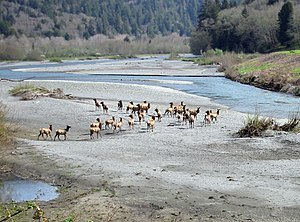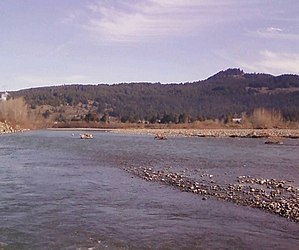| Total population | |
|---|---|
| merged into Hupa people | |
| Languages | |
| Hupa (Whilkut dialect) | |
| Related ethnic groups | |
| Hupa people, Chilula |


The Whilkut (variants: Whiylqit, Hwil'-kut, Hoilkut, Hoilkut-hoi) also known as "(Upper) Redwood Creek Indians" or "Mad River Indians" were a Pacific Coast Athabaskan tribe speaking a dialect similar to the Hupa to the northeast and Chilula to the north, who inhabited the area on or near the Upper Redwood Creek and along the Mad River except near its mouth (with the North Fork Mad River), up to Iaqua Butte, and some settlement in Grouse Creek in the Trinity River drainage in Northwestern California, before contact with Europeans.
Subdivisions
The Whilkut may then be divided into four subgroups (tribelets):
- the Chilula Whilkut (Lower Redwood Indians) (by Goddard and Kroeber the ″Chilula Whilkut″ would occupy essentially the territory assigned to the Chilula and are considered a separate tribe called Chilula)
- the Kloki Whilkut / Prairie Whilkut' (Tł'o:q'-xwe / Xontehł-xwe - "Prairie People" or Tł'o:q' Xwiy¬q’it - "Prairie Whilkut", also: "(Upper) Redwood Creek Indians"; about 12 villages along Upper Redwood Creek)
- the Mad River Whilkut (Me:w-yinaq / Me:w-yinuq, Mawenok - "underneath - upstream", also: "Mad River Indians"; about 16 villages along Mad River, Maple Creek and Boulder Creek), and
- the North Fork (Mad River) Whilkut (also: "Blue Lake Whilkut", about six villages along North Fork Mad River and in Blue Lake area (Yitse'ni-xohch'indił-ding).
Known Whilkut villages: ch'iłq'un-ding, mił-tehsch'e:-me'.
The common tribal name as "Whilkut" is an adaption from the Hupa name for the Redwood Creek respectively the Redwood Ridge / Bald Hills as Xwiy¬q'it / Xwe:ył-q'it / Xoył-q'it.
The Whilkut (together with Chilula) were called by the neighboring Hupa-speaking peoples Xwiy¬q'it-xwe / Xwe:yłq'it-xwe ("Redwood Ridge / Bald Hills People"), therefore they were also known as (Upper) Redwood Creek Indians. Because of their close Hupa kin they are also called Upper Redwood Creek Hupa or Upstream Redwood Creek Hupa.
Most authors consider class the Chilula as a separate people, sometimes they are also considered another fourth tribelet (subgroup) of the Whilkut and are called the Chilula Whilkut.
Little is known of the Whilkut culture beyond its similarity to that of the Hupa and criticized by the Hupa and Chilula as guarded, traditional, less settled hill people. Following the gold rush in Northwestern California, routes of pack trains between Humboldt Bay and Weaverville, California, lay through their territory, and their population, never large, was drastically reduced in the 1858-1864 Bald Hills War. Estimated to have 250-350 warriors at the start of the war, the survivors were taken to the Hupa reservation soon after its establishment. After 1870 they drifted back to their traditional homes where they continued to live. Only 50 remained in the 1910 census. In 1972 only a remnant was left, perhaps only 20 to 25 individuals.
Whilkut descendants have since been incorporated into the Hupa:
- Hoopa Valley Tribe (Hoopa, Humboldt County, Population 2013: 3.139) (Hupa, Tsnungwe, Chimalakwe, Chilula, Whilkut)
- Blue Lake Rancheria (Blue Lake, Humboldt County, Population 2010: 58) (Wiyot, Yurok, Hupa, Whilkut)
References
- California Athabascan Groups
- Letter from General Kibbe to Governor Weller, State Archives, 1858
- Kroeber, Handbook of the Indians of California, p. 141
- Robert Heizer, William C. Sturtevant, Handbook of North American Indians: California, Volume 3; Government Printing Office, Washington, 1978; Whilkut, pp. 178-179
- "Hoopa Valley Tribe". Archived from the original on 2020-08-26. Retrieved 2020-08-23.
- "Blue Lake Rancheria". Archived from the original on 2020-10-23. Retrieved 2020-08-23.
Further reading
- Alfred Louis Kroeber, Handbook of the Indians of California, Volume 1, Kessinger Publishing, 2006, pp. 123, 141.
- Hupa, Chilula, and Whilkut by William J. Wallace from Robert Heizer, William C. Sturtevant, Handbook of North American Indians: California, Volume 3, Government Printing Office, Washington, 1978, pp. 178-179
See also
|
This article relating to the Indigenous peoples of North America is a stub. You can help Misplaced Pages by expanding it. |